#Akhmim
Explore tagged Tumblr posts
Text

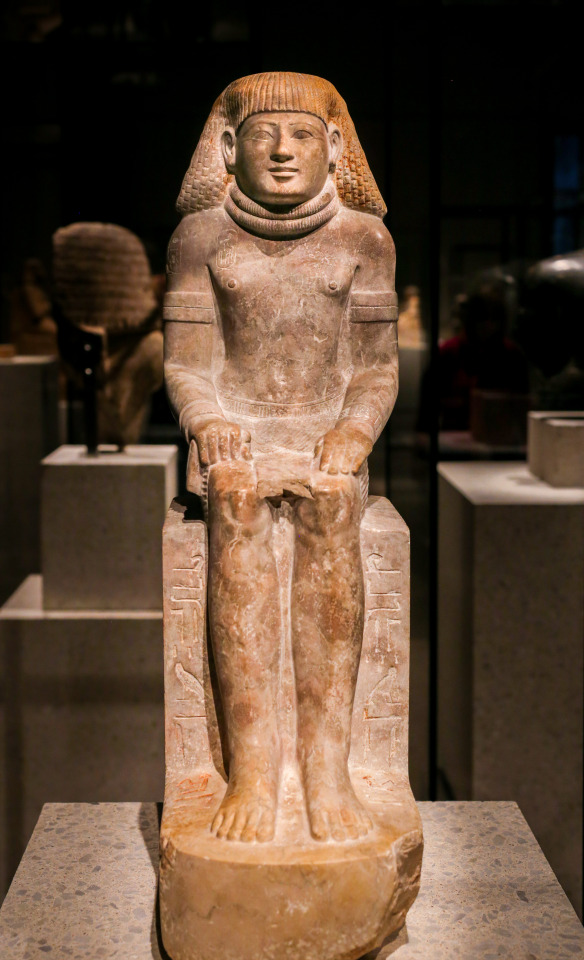




Sitting figure of Maja - Staatliche Museen zu Berlin Collections
Inventory Number: ÄM 19286 Tutmose III (18th Dynasty, New Kingdom, Egypt) Location Information: Akhmim (? / Egypt / Middle Egypt)
Description:
Maja was a high official of the provincial administration. He was installed as Gouverneur and head of the Priests in the 10th upper egyptian district by king Tutmose III, who's name is written on the chest and right upper arm. His grave was found in the necropolis of the main settlement of that district and it is speculated that this figure was also from there. Maja sits upright on a simple stool. The text tells us names and titles of the deceased, as well as the sacrificial rites for the local deities. He is dressed in a short skirt, originally reserved for the kings, but later also found with private persons. He holds in his right hand a sweat cloth, while the left isflat on his skirt. The round expressionless face is, like the entire figure, structured very formal. A wig that was in keeping with the taste of the time was literally placed over the head. The two necklaces, consisting of disc pearls, as well as the massive upper and lower arm bracelets, are awards made of gold that the king had given him. They probably indicate former military service.
Credit: Staatliche Museen zu Berlin, Ägyptisches Museum und Papyrussammlung / Jürgen Liepe
Other Images Used for Display:
Wikimedia Commons, @ User ArchaiOptix
Wikimedia Commons, @ User ArchaiOptix
Wikimedia Commons, @ User ArchaiOptix
Wikimedia Commons, @ User ArchaiOptix
Wikimedia Commons, @ User ArchaiOptix
#Sitting figure of Maja#Staatliche Museen zu Berlin#Ägyptisches Museum und Papyrussammlung#ÄM 19286#dynasty 18#new kingdom#new kingdom pr#Akhmim#middle egypt#upper egypt#mens clothing#NKPRMC
4 notes
·
View notes
Text

Textile Worker in Akhmim
Inji Efflatoun
15 notes
·
View notes
Text

Lady Thuya, Superintendent of the Harem of the god Min of Akhmin and of Amun of Thebes.
New Kingdom, 18th Dynasty, ca. 1391-1353 BC. From Coptos or Akhmim. Now in the Louvre. E 10655
165 notes
·
View notes
Text

Face of the coffin of the “Belgrade mummy”, ancient Egyptian mummy from the Ptolemaic period, late 4th-early 3rd century BC around 300 years BC, from the collection of the National Museum of Serbia in Belgrade.
The coffin with the mummy was purchased in Luxor, Egypt, by Pavle Riđički in late 19th century, who donated it to the National Museum of Serbia in 1888.
This antropoid (human-like) coffin contains a mummy of Nesmin, ancient Egyptian priest from Akhmim, some 200 kilometers north of Luxor. Name Nesmin means “The one who belongs to god Min”. In 1885 in Luxor a stone stele was found, carved with inscription dedicated to Nesmin and his family, saying thet Nesmin, as all his male ancestors, was a priest in a temple dedicated to Min, god of fertility and harvest. The stele is now kept in Egyptian Museum in Kairo in Egypt.
The coffin is made of the tamarix wood, and it used to be richly decorated with painted motifs in vivid colors and some details in gold. Only traces of the coloration are now preserved. Below the chin is a hole which used to hold a ceremonial beard. Eyes and eyebrows on the face of the coffin were made of blue glass paste, and face was covered with gold. In the stomack area is painted goddess Nut with spread wings, and below are two symetrical figures of god Anubis.
Lower part of the lid also bears and important hieroglyphic inscription, a passage from the Egyptian Book of the Dead, chapter 191 dedicated to the return of the soul into the body. This chapter is rarely find on the coffins, only about 20 coffins with this text are known so far.
Dimensions of the coffin – 182.5 x 52 x 42 cm.
Arms of the Nesmin’s mummy were crossed on the chest, and nails on his hands and toes were covered with gold. Eyes were replaced with non-metalic implants. Within the banages of the mummy were found different amulets made of gold, lapis lazuli semi-precious stone and faiance representing djed pillars, gods Nephtys, Horus, Isis and Maat, Eye of Horus and heart amulet, along with composite necklace comprised of many faiance beads. The mummy also contained papirus scroll of the Book of the Dead.
Cartonage mask and cover of the mummy are preserved only in framents, on which are visible falcon heads painted on the collar, and figures of goddesses Isis, Nephtys and Nut and some minor deities.
Anthropological analysis showed that Nesmin suffered from spine deformities spondylosis and scoliosis. He was around 165 cm tall and was about 50 years old when he died.
The coffin and Nesmin’s mummy are currently kept in Archaeological collection of Faculty of Philosophy in Belgrade
61 notes
·
View notes
Text

Portion of a garment of linen worked in purple wool with various animals in sequence and wavy line: Ancient Egypt, Coptic, from Akhmim, Upper Egypt.
5 notes
·
View notes
Text

Fragment of leaf-shaped textile. Akhmim, Egypt / Early Byzantine 4-6 c. AD. Unbleached linen ground weave with tapestry areas in red-brown wool and linen thread
8 notes
·
View notes
Text
The good name
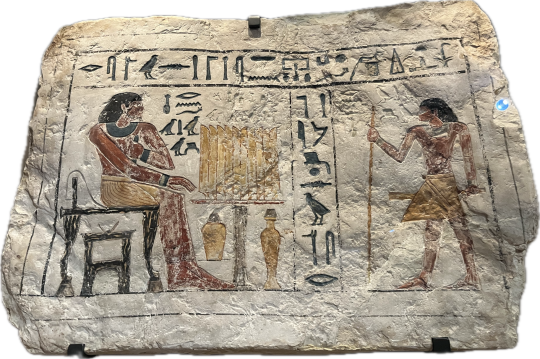
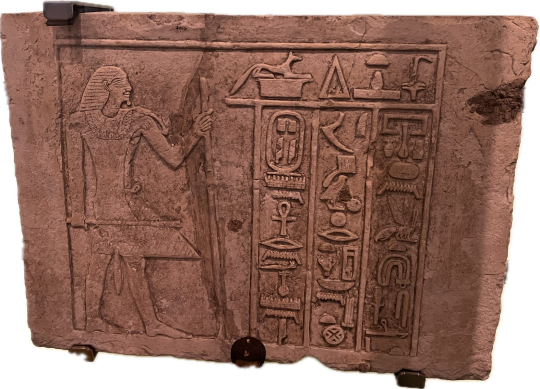
As this has come up occasionally - what were Egyptian names like, what were Egyptians called... I've just looked through pictures I took at museums and noticed that I do have a few nice examples where peoples "good names" are given.
The first is a stela from Akhmim, dating to the Old Kingdom, which shows a man called wsr-mjn (Usermin) in front of an offering table (left side). His name is given in the upper line with the offering formula and then again with his title Hm-nTr (priest) in the middle column. In front of him there's another name: His rn-nfr, his good name - which was Wedja. This would have possibly been a name he would have been called in life, similar to a nickname. The stela is now in the Scottish National Museum but unfortunately their display does not offer an accession number.
The second piece was once part of a limestone false door and dates from the Old Kingdom as well, this time coming from Dendera. The man shown on the left is called ppj-mn-anX (Pepi-Men-Ankh) which is given in the last column of the text. You can clearly see that the name is basilophorous, i.e. it incorporated the king's name, because that part is framed with a cartouche. Underneath that name, again, there's his rn-nfr: Mnj (Meni). The fragment is now in the Manchester Museum and has the number 3503.
18 notes
·
View notes
Text
Scientific research supports the accuracy of Herodotus' report on mummification
"David Counsell
Proving Herodotus and Diodorus?
Headspace analysis of ‘eau de mummy’ using gas chromatography mass spectrometry
Abstract
Historical accounts of the mummification process from Herodotus (5th century BC) and Diodorus Siculus (1st century BC) report the use of a wide range of aromatic plant materials, including many common herbs and spices. Mummified remains consistently emit a musty odour, likely derived from residues of these materials. Using a sampling technique, novel in archaeology, the constituents of this odour were analysed using GCMS. The sample utilised was from a particularly pungent mummy from the Leicester Museum collection; Bes-en-mut, a priest in the temple of Min at Akhmim c. 700 BC. The results revealed the presence of a wide range of turpenoid and other compounds derived from a range of aromatic plants, including well known herbs and spices such as Cinnamon and Rosemary. The abundance of these compounds in nature make it difficult to identify in most cases exactly which plants were actually used in the embalming of Bes-en-mut, with one exception. The identification of juniperol, which is unique to the common juniper, Juniperus communis, confirms the use of juniper oil in the mummification process. Overall the results support the accuracy of the historical reports particularly that of Herodotus, whose authenticity has often been called into question."
David Counsell "Proving Herodotus and Diodorus? Headspace analysis of ‘eau de mummy’ using gas chromatography mass spectrometry", in Mummies, magic and medicine in ancient Egypt. Multidisciplinary essays for Rosalie David (edited by Campbell Price, Roger Forshaw, Andrew Chamberlain and Paul Nicholson with Robert Morkot and Joyce Tyldesley), Manchester University Press, 2016
David Counsell qualiied in medicine at Leicester in 1982 and became a consultant cardiothoracic anaesthetist at Blackpool in 1991. From 2001 he was a consultant in Wrexham and from 2010 to 2015 Chief of Staf in Anaesthetics, Pain and Critical Care at Nuield Health, The Grosvenor Hospital. He obtained the Certiicate in Egyptology at the University of Manchester in 1996 and was awarded a PhD for his research into drug and intoxicant use in ancient Egypt. He became an Honorary Research Associate at the KNH Centre for Biomedical Egyptology at Manchester University and has lectured, published papers and made television appearances relating to opium, the blue lotus, cocaine, nicotine and the death of Tutankhamun (source: https://www.academia.edu/26057393/Mummies_Magic_and_Medicine_in_Ancient_Egypt_Multidisciplinary_Essays_for_Rosalie_David.)
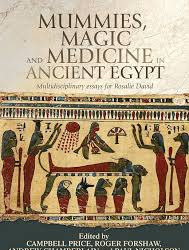
3 notes
·
View notes
Text
Zosimos was active around 300 AD.10 He was born in the Upper Egyptian city of Panopolis, now called Akhmim. We know that he was not the first chrysopoeian, because his writings refer to earlier authorities, and even to rival “schools” of alchemical thought that had already developed by his time. (Of these other schools we know absolutely nothing save what he writes in criticism of them.)
– Lawrence M. Principe, The secrets of alchemy.
0 notes
Text
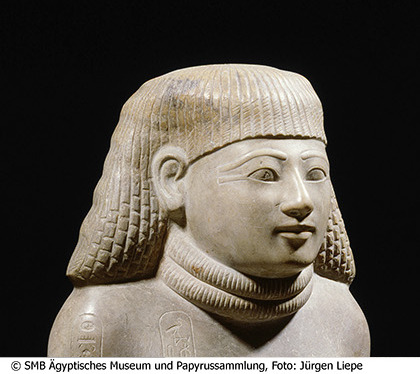

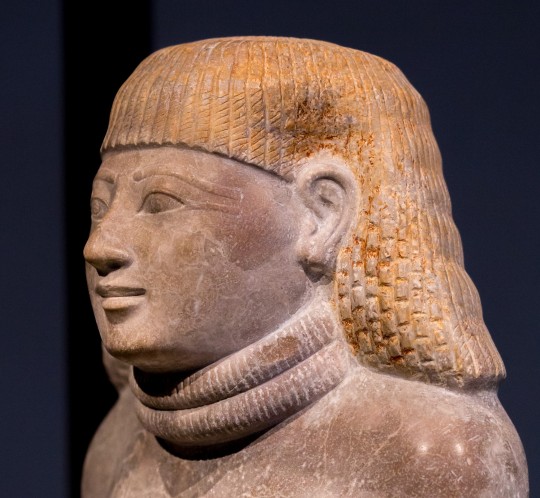
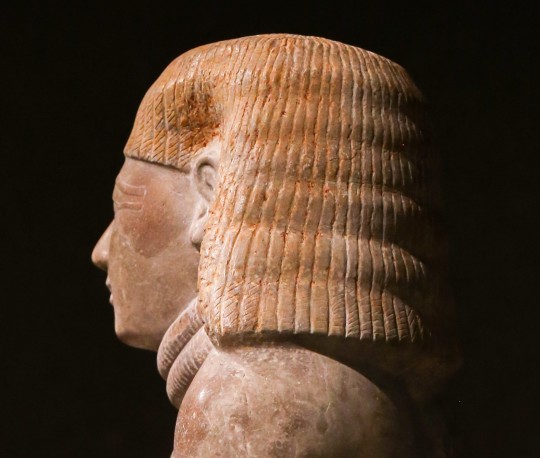


Sitting figure of Maja - Staatliche Museen zu Berlin Collections
Inventory Number: ÄM 19286 Tutmose III (18th Dynasty, New Kingdom, Egypt) Location Information: Akhmim (? / Egypt / Middle Egypt)
Description:
Maja was a high official of the provincial administration. He was installed as Gouverneur and head of the Priests in the 10th upper egyptian district by king Tutmose III, who's name is written on the chest and right upper arm. His grave was found in the necropolis of the main settlement of that district and it is speculated that this figure was also from there. Maja sits upright on a simple stool. The text tells us names and titles of the deceased, as well as the sacrificial rites for the local deities. He is dressed in a short skirt, originally reserved for the kings, but later also found with private persons. He holds in his right hand a sweat cloth, while the left isflat on his skirt. The round expressionless face is, like the entire figure, structured very formal. A wig that was in keeping with the taste of the time was literally placed over the head. The two necklaces, consisting of disc pearls, as well as the massive upper and lower arm bracelets, are awards made of gold that the king had given him. They probably indicate former military service.
Credit: Staatliche Museen zu Berlin, Ägyptisches Museum und Papyrussammlung / Jürgen Liepe
Other Images Used for Display:
Wikimedia Commons, @ User ArchaiOptix
Wikimedia Commons, @ User ArchaiOptix
Wikimedia Commons, @ User ArchaiOptix
Wikimedia Commons, @ User ArchaiOptix
Wikimedia Commons, @ User ArchaiOptix
#Sitting figure of Maja#Staatliche Museen zu Berlin#Ägyptisches Museum und Papyrussammlung#dynasty 18#new kingdom#new kingdom pr#Akhmim#middle egypt#upper egypt#ÄM 19286#mens hair and wigs#NKPRMHW
3 notes
·
View notes
Text

Min is an Egyptian god associated very strongly with fertility He had a particular center of worship at Akhmim. Min is depicted here as a man with black skin, symbolizing the fertile Nile soil, with an erect phallus, wearing the double-plumed crown. He carries the flail.
Bountiful Min, virile and strong, lord of the black earth, the swell of tender green, I praise and honor you.
1 note
·
View note
Text
Le palais de Mohammed Ali à Shubra et le musée des capitales d'Egypte... 4 immenses projets archéologiques "prêts" à ouvrir

Le ministre égyptien du Tourisme a révélé que quatre grands projets seront bientôt ouverts après leur achèvement, Le ministre égyptien du Tourisme a révélé que quatre grands projets seront bientôt ouverts après leur achèvement, Il s'agit du développement de jardins autour de la citadelle de Saladin au Caire, qui est considérée comme l'un des lieux touristiques islamiques les plus importants, Outre le palais de Mohammed Ali au Caire, il y a aussi le musée des Capitales dans la nouvelle capitale administrative, Si nous descendons en Haute Égypte, nous trouverons le monastère des Martyrs au mont Akhmim à Sohag, Voici tous les projets qui ont été réalisés pour promouvoir le tourisme et l’intérêt pour les antiquités en Égypte.
Cependant, quelques projets merveilleux ont été ouverts l'année précédente, y compris la mosquée Muhammad Ali à Rashid, Le manuscrit du Livre des Psaumes se trouve au Musée copte du Vieux Caire, et il existe de nombreuses autres œuvres que vous devriez visiter.
Comment visiter ces endroits merveilleux et comment partir en voyage alors que je ne connais pas grand-chose de l’Égypte ?
Je voudrais vous dire qu'il est facile de connaître beaucoup de choses sur l'Égypte, et c'est un guide touristique de voyage à travers l'Égypte qui vous aidera avec tout ce que vous voulez savoir.
Une fois que j'aurai pris connaissance des informations, le voyage en Égypte sera-t-il agréable et me fournira-t-il tout ce que je veux ?
Bien sûr, si vous venez pour une raison quelconque, vous trouverez ce que vous voulez, Par exemple, il existe ici différents types de tourisme, des hôtels et les restaurants les plus luxueux qui vous proposent tous types de nourriture, qu'ils soient égyptiens ou étrangers, il y a aussi le Nil et ses merveilleuses croisières sur le Nil, la Haute Égypte et ses antiquités, ainsi que les merveilleuses villes balnéaires et bien plus encore.
Que nous a laissé la civilisation islamique en Egypte en termes de monuments et d'histoire ?
Il nous a laissé de nombreuses choses merveilleuses que les touristes du monde entier visitent, Par exemple, la rue El Moez au Caire se distingue par ses détails anciens qui reflètent l’influence de la civilisation islamique en Égypte.
La civilisation islamique nous a également laissé d’autres lieux merveilleux, notamment la mosquée Al-Hussein, considérée comme la plus ancienne mosquée du Caire, elle a été fondée à l'époque fatimide, Cette mosquée est considérée comme très spéciale pour les musulmans car elle contient la plus ancienne version du Coran.
C'est une expérience complètement différente que de visiter des lieux historiques où vous pouvez aller au centre-ville, monter jusqu'à la tour du Caire grâce à un télescope, vous pouvez voir de nombreux endroits d'en haut et c'est une expérience merveilleuse et différente.
- Alors l'expérience de visiter ces endroits merveilleux, et découvrir le circuit en Egypte, la météo au Caire, Ou le reste des gouvernorats pour écouter tout ce qui fait la particularité de l'Égypte et de sa grande histoire.
#cairo top tours#egypt tours#cairo tours#mosque in cairo#travel#travel and tourism#travel and vacations
0 notes
Text

The mummies of Yuya (left) and Tuyu (right)
Yuya & Thuya’s tomb was the most famous “untouched” tomb until 16 years later with the discovery of Tutankhamun’s a few years later (Thuya & Yuya’s great-grandson). The tomb of Yuya and Thuya was, until the discovery of Tutankhamun’s, one of the most spectacular ever found in the Valley of the Kings despite Yuya not being a king.
Although the burial site was robbed in antiquity, many objects not considered worth plundering by the robbers remained. Both the mummies were largely intact and were in an amazing state of preservation. Their faces in particular were relatively undistorted by the process of mummification, and provide an extraordinary insight into the actual appearance of the deceased while alive.
Yuya was a courtier from Akhmim, Egypt, with titles such as "King’s Lieutenant Master of the Horse Father-of-the-god". His mummy was found in the Valley of the Kings alongside his wife Thuya's in Tomb KV46 in 1905 by British Egyptologist James Edward Quibell.
The mummy of Yuya was found partially wrapped with only his torso being divested of wrappings by ancient robbers. When the body of Yuya was removed from his innermost coffin, a partially strung necklace composed of large gold and lapis lazuli beads was found behind his neck, where it had presumably fallen after being snapped by looters.
Sir Grafton Elliot Smith describes the mummy of Yuya as one of the finest examples of the embalming practices of the 18th Dynasty. The mummy is that of an older man. His thick, wavy hair is a yellowish color, and was probably bleached by the embalming materials rather than being naturally blonde.
Smith says the hair was white when Yuya died. His body cavity was packed with balls of linen soaked in resins, and his perineum is thickly coated with resinous material to such an extent that his genitals are completely covered.
Read more
The well-preserved mummy of Thuya shows a woman of around 50–60 years of age. She measures at 145cm tall (4ft 9.1). Thuya’s body was discovered laying serenely within her coffin, with a large linen shroud knotted at the back and secured by four bandages, leaving her feet and face exposed.
Douglas Derry, accompanying anatomist Grafton Elliot Smith whilst examining the body of Thuya, discovered she was wearing gold foil sandals upon her feet. Thuya’s arms lay alongside her body with her hands flat. Her ears are double pierced. Her mummy has the inventory number CG 51191.
C.T. scanning of Thuya’s mummy show a smooth lateral curve of the spine, with its convexity to the left (thoracolumbar scoliosis), with a Cobb angle of 25 degrees.
Thuya is missing various teeth, with the right premolar and left first molar missing. Thuya also has a damaged, half broken second molar tooth on the left. The damage to Thuya’s teeth was more than likely pre-mortem, meaning it happened during her lifetime. There are multiple Egyptian mummies who tend to have abscesses and dental issues, including Ramesses II, also known as “Ramesses the Great”.
The damage to Thuya’s teeth and scoliosis, would fit with the estimated age range of her body at death. However, the C.T. scans did not reveal a possible cause of death for Thuya.
Read more
49 notes
·
View notes
Note
Okay, so here's the thing.
I couldn't find any reference to what is mentioned in the notes in the picture above, BUT there is something else.
Josephus Flavius writes (94 AD) about a very strange incident in "The Antiquities of the Jews" (18.65-80) that supposedly happened in the time of emperor Tiberius. The story is about a Roman athlete who fell in love with a married woman, who rebuffed his advances. When he threatens to starve himself out of heartbreak, his servant devised a plan and bribed the priests in a temple of Isis in Rome, who gave the athlete their regalia which included a mask in the shape of Anubis. The priests then convinced the woman, who was a devout Isiac, that the god Anubis himself wants to have sex with her. Excited she gets the permission of her husband to spend the night with the "god" at the temple, and he says yes. She meets "Anubis" and they go at it al night long, only for the athlete to reveal his deception to her a couple of days later. Long story short, the couple complains to Tiberius, the priests and servant are crucified, the athlete is banished and the Isiac cult is banned in Rome.
David Klotz claims that this story is based on real rituals [“The Lecherous Pseudo-Anubis of Josephus and the ‘Tomb of 1897’ at Akhmim”]. He bases his opinion on several points which are not relevant here, as well as a weird wall painting from an Egyptian tomb from the Roman period:

In his opinion, the image on the right shows a sexual encounter between Anubis and a woman.
That said, Valentino Gasparini rejects this interpretation of the story entirely ["Negotiating the body: Between religious investment and narratological strategies. Paulina, Decius Mundus and the priests of Anubis"]. These are the most important points that should be mentioned:
There is another story in Antiquities about a Jewish man who convinces a noble Roman Jewish woman to give him extremely expensive items to take to the temple in Jerusalem, but he disappears with the items, causing the the woman and her husband to complain to Tiberius, who then expelled all the Jews from Rome to Sardinia. Sounds a bit similar doesn't it?
There are actual reports by Tacitus and Suetonius that during Tiberius' 19th year he has taken measures both against the Isaic cult and the Jews.
So, it is possible that the very similar stories in Antiquities are trying to explain real historic events. It is also possible that Josephus didn't invent them himself but simply repeated existing narratives. But Gasparini also thinks that these stories are specifically in conversation with other passages about Christianity, and that their purpose is to criticize the followers of Jesus, especially the Jews among them.
There is also a lot to say about the "otherness" of Egypt in the eyes of both Romans and Jews in ancient times, and how Anubis as a Jackal/Dog headed god played a part in this.
It should also be noted that technically speaking the Isiac priests aren't the ones having sex with the masks in the story, as well as the fact that we aren't just talking about Egyptian rituals in Roman times but of actual Romans who are practicing them.
So, considering there is no reference (that I could find at the moment) to any sort of sexual conduct of priests of Anubis while wearing his mask, ritualistically or otherwise, I am inclined to say that neither they nor any other Egyptian would be too kin of the Anubis-themed furry pornography.
That said, I am very perturbed by that wall painting, especially since Gasparini didn't actually address it at all in his paper. He had excellent other points to refute Klotz's theory, but he never directly talked about the painting, and to be honest I am finding it hard to interpret it any other way... It should be emphasized again that even this painting is from the Roman period. The thing about Egyptian history is that by the time of the late period (Dynasty 22 onward, first millennia BC) Egyptians themselves have gradually lost a lot of their own cultural understanding, as the reading of Hieroglyphs decreased and the religion got more and more influenced by outside forces and the empires that conquered Egypt.
So, what I'm saying is that technically speaking, while Egyptians and Egyptian priests in particular in earlier periods probably did not participate in such behavior, in private or in ritual, nor support it, I can't tell you for certain what they or their Roman counterparts did in the Roman period, and so I can't tell you for certain whether or not these guys would or wouldn't be okay with Anubis-themed furry pornography.
how would the clergy of ancient Egypt (let’s assume from one of the later dynasties) feel about modern Anubis-themed furry pornography?
I have no idea. I'd have to find an egyptologist to ask.
#why would i have archaeology degrees if not to research this sort of things?#i'm glad my money was spent well#hope i helped#archaeology#ancient egypt
8K notes
·
View notes
Text
Exporter of Flash Dryer in Egypt

Drytech Engineering Systems is an Exporter of Flash Dryer in Egypt. We Specialized Spray Dryer, Flash Dryer, Spin Flash Dryer, Multi Effect Evaporator Etc. Drytech Engineering Systems is a Flash Dryer Manufacturer in Ahmedabad, Gujarat, India. Flash Dryer employs a high-velocity stream of hot air to rapidly dry suspended materials like powders, granules, and pastes, swiftly removing moisture. This continuous system ensures quick evaporation, yielding dry products in seconds. Working Principle of Flash Dryers Material Feeding: Wet material enters the flash dryer via a screw feeder, rotary valve, or pneumatic conveyor. Hot Air Generation: The Heater generates hot air in the dryer, adjusting the temperature for the material's characteristics. Material Dispersion: The system disperses wet material in the chamber with high-velocity hot air for efficient drying. Moisture Evaporation: Material moisture evaporates quickly in hot air; evaporated moisture exits with exhaust air from the system. Product Collection: Dry material, with reduced moisture, is separated using a cyclone separator or bag filter, expelling moist air. Control Systems: Advanced control systems oversee and adjust air temperature, airflow rate, and material feed for optimal drying performance. Application: Drying of Vegetable Protein, Wheat Starch, Meat Residue, Cement, Blowing Agents, Corn Gluten. Drytech Engineering Systems is an Exporter of Flash Dryer in Egypt including locations like Cairo, Aswan, Luxor, Alexandria, Giza, Faiyum, Hurghada, Asyut, Ismailia, Port Said, Suez, Zagazig, Mansoura, Tanta, Minya, El-Mahalla El-Kubra, Qena, Banha, Damietta, Damanhour, Beni Suef, Shebeen El-Kom, Shubra Al Khaymah, Arish, Sohag, Kafr El-Shaikh, Rasheed, Esna, Juhaynah, Akhmim, Malawi, Fayed, El Matareya, Madinet Borg Al Arab, Natrn Valley, Desouk, Qalyub, Al Obour City, Edfu, Sharm El-Sheikh, Marsa Matruh, Bilbeis, Kafr El-Dawar. For detailed information and inquiries, please feel free to contact us. View Product: Click Here Read the full article
0 notes
Text
Exporter of Screw Conveyor in Egypt

R Mech Machines LLP is a Manufacturer, Supplier, and Exporter of Screw Conveyor in Egypt. R Mech Machines LLP Specializing in Plastic Scrap Turbo Washing Machines, Plastic Scrap Grinder Machines, Plastic Scrap Shredder Machines, Blade Sharpening Machines, Screw Press Squeezer Machines, Friction Washer Machines, and more. As a premier manufacturer, we specialize in crafting top-of-the-line screw conveyors renowned for their quality and reliability. Screw conveyors serve as essential tools in material handling, effortlessly transporting bulk materials to desired locations, whether uniform or inclined. Their primary function includes breaking down material chunks, making them ideal for conveying various types of materials, from dry and coarse to sluggish and liquid. Materials are precisely moved in predetermined quantities from inlet to outlet, with adjustments made based on conveyor size and capacity. We offer companies the latest and most advanced screw conveyor options, ensuring efficient operations and optimal performance. Our conveyors undergo rigorous design and manufacturing processes, overseen by quality controllers, skilled engineers, and dedicated teams. Designed to meet the diverse needs of industries like agriculture, food processing, and mining, our screw conveyors guarantee efficient material transport. R Mech Machines LLP is an Exporter of Screw Conveyor in Egypt and various locations like Cairo, Alexandria, Suez, Zagazig, Qena, Akhmim, Desouk, Qalyub, Luxor. For more information, please feel free to contact us. Read the full article
0 notes